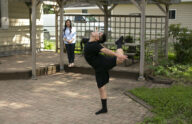Preliminary injunction sought in Minnesota dance case
Dmitri Moua and Zachary Greenwald are Minnesota high school juniors who love to dance. But due to a state-sanctioned rule in Minnesota, boys are prohibited from trying out for high school competitive dance teams. To remedy that outdated and discriminatory rule, in July we challenged it as a violation of the 14th Amendment’s Equal Protection Clause and Title IX. Because both boys have already been excluded from two years of competitive dance, we are also asking the court to grant a preliminary injunction to allow the boys to try out this school year. This week we completed briefing for the motion with the filing of our reply.
Whenever government-sanctioned official rules and policies discriminate on the basis of sex, courts will declare them invalid unless they are substantially related to achieving important governmental objectives. In this case, the Minnesota State High School League (MSHSL) has provided no evidence that it has any interests that are furthered by the restrictive rule, nor has it presented any evidence that it has interests that are substantially related to keeping boys out of dance. Instead, MSHSL has offered hypothetical justifications based on old assumptions and old data. That will not suffice.
Briefly, MSHSL argues that making dance girls-only serves to increase athletic opportunities for girls, remedy past discrimination against girls in athletics, promote safety, and preserve athletic competition. But there is no evidence that MSHSL created dance as girls-only in order to increase opportunities for girls rather than, say, because it assumed no boys like to dance. Further, there is no evidence that restricting dance to girls creates any additional opportunities over and above simply establishing dance team in the first place. Indeed, MSHSL admits that it knows of only three boys (including Dmitri and Zachary) who have ever expressed interest in joining a school dance team—and that’s despite the fact that dance has been a sanctioned activity since 1996. Thus, the evidence actually shows that discriminating against boys does nothing to enhance opportunities for girls.
Likewise, MSHSL relies on old data showing minor disparities in the representation of females in Minnesota high school athletics. While the four-year average of under-representation for girls has dropped to 0.39%, MSHSL also ignores that the last two years have seen the disparity for boys develop into an emerging trend. Therefore, the evidence undercuts MSHSL’s assertion that locking boys out of dance addresses discrimination against girls. Nor is there any evidence that safety and competition are enhanced by keeping boys from competing alongside girls. In fact, the opposite is true. Across the country, and for years, boys and girls have performed on the same competitive dance teams. If there have been any documented safety or competitive concerns, MSHSL has failed to produce evidence of them.
As a result, because MSHSL has failed to meet its burden of proof, we are hopeful the court will enter a preliminary injunction and allow Dmitri and Zach to dance this year. A hearing on the motion will be held in St. Paul, Minnesota on September 26. We hope for a positive decision soon thereafter.



